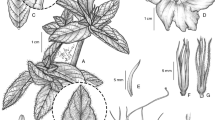Abstract
The leaves of Caladium steudneriifolium (Araceae) of the understorey of a submontane rainforest in the Podocarpus National Park (South East Ecuador, 1,060 m a.s.l.) are plain green or patterned with whitish variegation. Of the 3,413 individual leaves randomly chosen and examined in April 2003, two-thirds were plain green, whereas one third were variegated (i.e., whitish due to absence of chloroplasts). Leaves of both morphs are frequently attacked by mining moth caterpillars. Our BLAST analysis based on Cytochrome-c-Oxidase-subunit-1 sequences suggests that the moth is possibly a member of the Pyraloidea or another microlepidopteran group. It was observed that the variegated leaf zones strongly resemble recent damages caused by mining larvae and therefore may mimic an attack by moth larvae. Infestation was significantly 4–12 times higher for green leaves than for variegated leaves. To test the hypothesis that variegation can be interpreted as mimicry to deter ovipositing moths, we first ruled out the possibility that variegation is a function of canopy density (i.e., that the moths might be attracted or deterred by factors unrelated to the plant). Then plain green leaves were artificially variegated and the number of mining larvae counted after 3 months. The results on infestation rate (7.88% of green leaves, 1.61% of the variegated leaves, 0.41% of white manipulated leaves and 9.12% of uncoloured manipulated leaves) suggest that ovipositing moths are deterred by the miner-infestation mimicry. Thus, variegation might be beneficial for the plants despite the implicated loss of photosynthetically active surface.



Similar content being viewed by others
References
Altschul SF, Gish W, Miller W, Myers EW, Lipman DJ (1990) Basic local alignment search tool. J Mol Biol 215:403–410
Augner M, Bernays EA (1998) Plant defence and Batesian mimicry. Evol Ecol 12:667–679
Barret SCH (1987) Mimicry in plants. Sci Am 257:68–75
Benson WW, Brown KS, Gilbert LE (1975) Coevolution of plant and herbivores: passion flower butterflies. Evolution 29:659–680
Bogner JS, Nicolson DH (1991) A revised classification of Araceae with dichotomous keys. Willdenowia 21:35–50
Croat T (1988) Ecology and life forms of Araceae. Aroideana 11:4–55
Croat T (1994) Taxonomic status of neotropical Araceae. Aroideana 17:33–60
Gilbert LE (1980) Ecological consequences of a coevolved mutualism between butterflies and plants. In: Gilbert LE, Raven PH (eds) Coevolution of animals and plants. University of Texas Press, Austin, pp 210–240
Givnish TJ (1990) Leaf mottling: relation to growth form and leaf phenology and possible role as camouflage. Funct Ecol 4:463–474
Grayum MH (1990) Evolution and phylogeny of the Araceae. Ann Missouri Bot Gard 77:628–697
Lev-Yadun S (2003) Why do some thorny plants resemble green zebras? J Theor Biol 244:483–489
Lev-Yadun S, Inbar M (2002) Defensive ant, aphid and caterpillar mimicry in plants. Biol J Linn Soc 77:393–398
Lev-Yadun S, Dafni A, Inbar M, Izhaki I, Ne’eman G (2002) Colour patterns in vegetative parts of plants deserve more research attention. Trends Pl Sci 7:59–60
Lev-Yadun S, Dafni A, Flashman MA, Inbar M, Izhaki I, Katzir G, Ne’eman G (2004) Plant coloration undermines herbivorous insects camouflage. BioEssays 26:1126–1130
Madison M (1981) Notes on Caladium (Araceae) and its allies. Selbyana 5:342–377
Maia ACD, Schlindwein C (2006) Caladium bicolor (Araceae) and Cyclocaphala celata (Coleoptera, Dynastinae): a well-established pollination system in the northern Atlantic rainforest of Pernambuco, Brazil. Pl Biol 8:529–534
Mayo SJ, Bogner J, Boyce PC (1997) The genera of Araceae. Royal Botanic Gardens, Kew, pp 67–71
Niemelä P, Tuomi J (1987) Does the leaf morphology of some plants mimic caterpillar damage? Oikos 50:256–257
Prokopy RJ, Owens ED (1983) Visual detection of plants by herbivorous insects. Ann Rev Entomol 28:337–364
Shapiro AP (1981) Egg-mimics of Streptanthus (Cruciferae) deter oviposition by Pieris sisymbrii (Lepidoptera: Pieridae). Oecologia (Berl.) 48:142–143
Simon C, Frati F, Beckenbach A, Crespi B, Liu H, Flook P (1994) Evolution, weighting, and phylogenetic utility of mitochondrial gene sequences and a compilation of conserved polymerase chain reaction primers. Ann Entomol Soc Am 87:650–701
Smith AP (1986) Ecology of a leaf color polymorphism in a tropical forest species: habitat segregation and herbivory. Oecologia (Berl.) 69:283–287
StatSoft, Inc. (2005) STATISTICA (data analysis software system), version 7.1. www.statsoft.com
Wiens D (1978) Mimicry in plants. Evol Biol 11:365–403
Williams KS, Gilbert LE (1981) Insects as selective agents on plant vegetative morphology: egg mimicry reduces egg laying by butterflies. Science 212:467–469
Acknowledgements
The Ministerio del Medio Ambiente del Ecuador granted our research permits, and the Deutsche Forschungsgemeinschaft financed our studies (LI 17-1, FOR 402/1-1 TP A8). Dr. Ulrich Meve (Bayreuth) helped with the preparation of Fig. 2. We thank Dr. Mark van Kleunen (Bern) for his careful editing.
Author information
Authors and Affiliations
Corresponding author
Rights and permissions
About this article
Cite this article
Soltau, U., Dötterl, S. & Liede-Schumann, S. Leaf variegation in Caladium steudneriifolium (Araceae): a case of mimicry?. Evol Ecol 23, 503–512 (2009). https://doi.org/10.1007/s10682-008-9248-2
Received:
Accepted:
Published:
Issue Date:
DOI: https://doi.org/10.1007/s10682-008-9248-2




